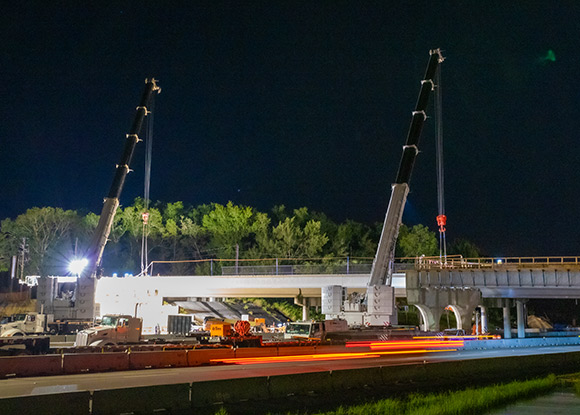Traffic Pacing Operations Keep
Roads Moving

|
| Overnight construction crews were able to place support beams for the new E.E. Williamson Road overpass thanks to a traffic pacing operation in June. |
| |
Whether setting bridge beams over Interstate 4 (I-4), installing overhead sign structures or replacing sign panels, the Florida Department of Transportation (FDOT) ensures traffic is always safely flowing when workers and machinery are present. If you’ve ever wondered, though, how this is possible without bringing traffic to a complete standstill or creating a difficult detour, it’s through a maintenance of traffic technique known as traffic pacing.
Typically performed during overnight hours, traffic pacing operations are an efficient way to keep roadways open by simply slowing traffic down several miles before the construction zone. Traffic Control Officers pace, or slow, the traffic to a speed that provides approximately 20-30 minutes of time to perform the overhead construction.
This method is being used during the reconstruction of the E.E. Williamson Road bridge over I-4 in Seminole County. For example, a weeklong traffic pacing operation in June was used to create a window for crews to place support beams for the new overpass. During the operations, westbound I-4 entrance ramps between certain interchanges were temporarily blocked by law enforcement officers. As the traffic pacing operation passed each interchange, law enforcement officers reopened the entrance ramp to allow motorists to enter I-4 and then join the slow roll of traffic.
Coordinating these efforts requires communication from various groups – including FDOT, construction crews, and law enforcement – working together to keep traffic moving unless there is an emergency. The heart of this operation is FDOT's Regional Transportation Management Center (RTMC), where crews monitor traffic and coordinate responses to incidents.
As the reconstruction of the E.E. Williamson Road bridge continues into 2021, motorists can anticipate more traffic pacing operations to take place.
Learn more about this I-4 construction project in Seminole County at I4Beyond.com/Seminole.
|
|
Stay Alert and Be Prepared During Hurricane Season
It’s month two of hurricane season, and here in Central Florida that means being prepared with supplies and a safety plan in place for families and organizations. For the Florida Department of Transportation (FDOT), it also means being prepared for storms that can cause major damage and flooding, especially in construction zones.
The I-4 Beyond the Ultimate team is ready to put its emergency preparation plans in place in case severe weather strikes Central Florida, implementing state-approved policies to keep the public and construction teams safe and to minimize damage to structures and equipment.
Detailed plans are essential, as the I-4 Beyond the Ultimate team is currently managing projects in Seminole County, such as the reconstruction of the E.E. Williamson Road overpass and the addition of an auxiliary lane on Interstate 4 (I-4) from the end of the I-4 Ultimate project to the eastbound I-4 exit to Lake Mary Boulevard.
When sustained winds are predicted to reach or to exceed 35 mph, it is an indicator that storm-safety procedures should start. During major storms, the roadways continue to be monitored by FDOT’s Regional Transportation Management Center (RTMC) in Sanford. This state-of-the-art, hurricane-ready facility is the nerve center for traffic management across nine Central Florida counties, ensuring that all roads remain safe. Additionally, the RTMC dispatch team works with the Florida Highway Patrol to safely manage roadways in the event there are evacuations leading up to a major storm.
After the storm subsides, the construction team inspects the site for damage, begins cleanup and drainage activities, and then promptly gets back to its regular work as soon as it is safe.
As a reminder, hurricane season lasts through November 30, but the peak time for hurricanes runs from mid-August to mid-October. The Florida Department of Highway Safety and Motor Vehicles also has information and links for those who want to make sure their own severe weather plans are up to date.
|
|
|




